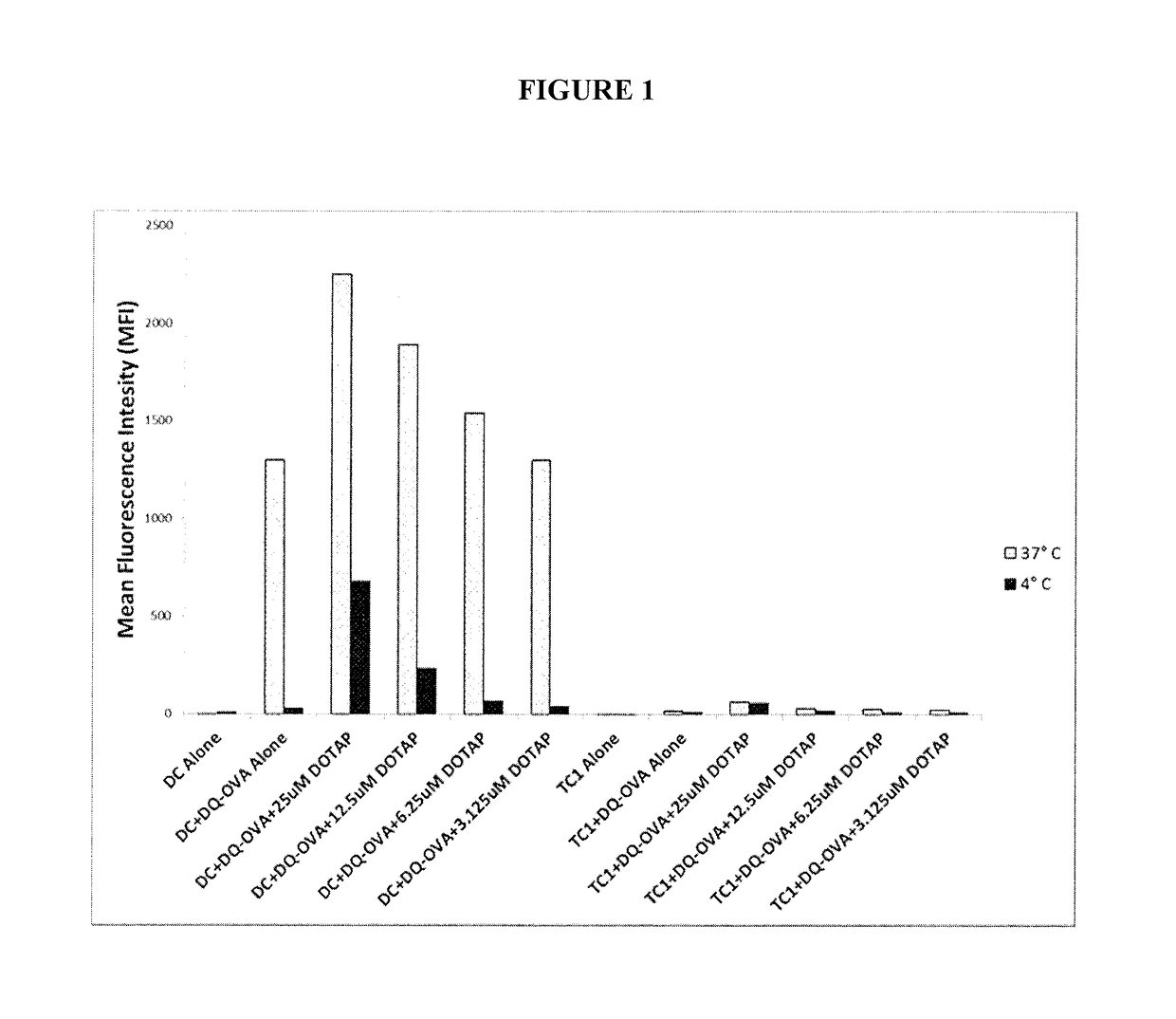Methods to alter the tumor microenvironment for effective cancer immunotherapy
a tumor microenvironment and immunotherapy technology, applied in the direction of antibody medical ingredients, dsdna viruses, drug compositions, etc., can solve the problem of not being able to reduce the population of immune suppressive regulatory t-cells within the tumor microenvironment, and achieve the effect of facilitating antigen cross-presentation, facilitating endosome destabilization, and rapid binding
- Summary
- Abstract
- Description
- Claims
- Application Information
AI Technical Summary
Benefits of technology
Problems solved by technology
Method used
Image
Examples
example 1
Effect of Cationic Lipids on Antigen Processing by Dendritic Cells and Epithelial Cells
[0096]To determine the effects of cationic lipids on antigen uptake and processing by dendritic cells, a fluorescent ovalbumin protein called DQ-OVA was used. DQ-OVA is non-fluorescent when intact, but emits both red and green fluorescence when the protein is degraded. Dendritic cells were grown from mouse bone marrow by culturing for 8 days in GMCSF+IL-4 (hereafter referred to as BMDC). BMDC were incubated at 37° C. or 4° C. for 1 hour with DQ-OVA alone, or DQ-OVA mixed with different concentrations of the cationic lipid R-DOTAP. The cells were then washed, fixed, and stained with fluorescent antibodies to CD1 1 c, a marker for dendritic cells. Cells were then analyzed on an LSRII flow cytometer in both red and green fluorescent channels.
[0097]Results in FIG. 1 show that BMDC incubated with DQ-OVA in media alone showed enhanced fluorescence at 37° C. indicating uptake and processing. This represe...
example 2
Comparison of Effect of Cationic Lipids on Antigen Processing and Endosomal Entry With Known Adjuvants
[0100]To determine whether non-cationic lipid adjuvants could mediate the same effect as DOTAP, BMDC were incubated with DQ-OVA in media alone or with DOTAP as described for FIG. 1. In addition, BMDC were incubated under identical conditions with the potent lipid adjuvant lipopolysaccharide (MPL). As shown in FIG. 2, DQ-OVA was actively taken up and processed by DC in the absence of R-DOTAP, but uptake was greatly enhanced in the presence of R-DOTAP and manifested as a strong increase in red fluorescence. In contrast, no such enhancement was observed with MPL treatment.
[0101]Monophorphoryl lipid-A (MPL) is a lower toxicity derivative of LPS that is now an FDA approved adjuvant in several vaccines.
[0102]It should also be noted that when the study was performed with S-DOTAP no difference in ability to enhance DQ-OVA uptake and processing was observed between R-DOTAP and S-DOTAP. A sim...
example 3
Effect of Cationic Lipids on Antigen Processing and Cross-Presentation to MHC Class I Restricted T Cells
[0104]In order to verify that the cationic lipid facilitated uptake of antigen translates into enhanced antigen presentation on MHC class I (cross presentation), T cells from a TCR transgenic mouse (OT-1) were utilized in which all T cells are specific for an internal peptide of OVA. These T-cells will only proliferate if presented with DCs which have processed OVA and presented an OVA peptide on MHC class I molecules. Thus, this represents a stringent assay for cross-presentation. BMDC were incubated with different concentrations of the whole OVA protein in the presence or absence of two cationic lipids, either DOTAP or DOTMA for 1 hour at 37° C. The DCs were then washed, fixed and added to the OVA peptide specific T-cells. The results in FIG. 3 show that DC incubated with OVA in the presence of the cationic lipids DOTAP or DOTMA cross-presented antigen to the CD8+ T cells much m...
PUM
| Property | Measurement | Unit |
|---|---|---|
| time | aaaaa | aaaaa |
| time | aaaaa | aaaaa |
| size | aaaaa | aaaaa |
Abstract
Description
Claims
Application Information
 Login to View More
Login to View More - R&D
- Intellectual Property
- Life Sciences
- Materials
- Tech Scout
- Unparalleled Data Quality
- Higher Quality Content
- 60% Fewer Hallucinations
Browse by: Latest US Patents, China's latest patents, Technical Efficacy Thesaurus, Application Domain, Technology Topic, Popular Technical Reports.
© 2025 PatSnap. All rights reserved.Legal|Privacy policy|Modern Slavery Act Transparency Statement|Sitemap|About US| Contact US: help@patsnap.com



